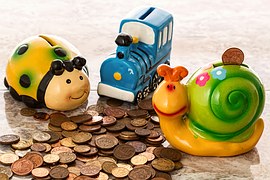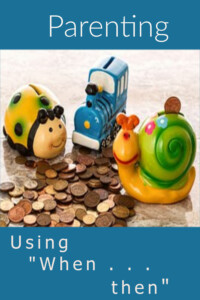Parenting: Using “When . . . then.”
 From “No” to “When . . . then . . . “
From “No” to “When . . . then . . . “
Use “When . . . then” with your kids, and it will change your parenting. It is easy to focus on the negative because that’s what it is: negative.
Our child shirks responsibility, does not follow a rule, or refuses to cooperate. We deal out consequences in many ways because there are many choices for the way we parent.
We say things like “No, you can’t have dessert. You didn’t finish your food.” OR “You can’t play because your homework is not done.” The focus is on what the child cannot do or is not allowed to do because of his lack of obedience or failure to complete a task. When your child knows your rules and understands them, he more readily follows them when it’s to his advantage.
It works better, I’ve found, if we can put a positive spin on the rule. The restriction is still there, but it puts the onus on the child instead of the parent. I call this When –then language.
Tell a kid not to think about pink elephants, and that’s all they’ll want to think about. What if, instead of saying, “Don’t think about pink elephants,” we say, “Think about ice cream!” Which is easier? To not think about something, or to think about something?
The older my kids got, the better I was at changing my tone. It helped that I had a lot of practice, and that I saw the difference it made.
Instead of saying, “You may not play ball with the others until your room is clean,” I started saying, “When your room is clean, then you can go outside to play.” Same rule, different approach with the child bearing responsibility instead of the adult.
It’s true: the same thing had to happen first (That room had to be cleaned.), yet the “reward” made it more reasonable and more doable. The child was now responsible for the task instead of the parent monitoring behavior, at least that’s how it worked in my house.
Focus on appropriate behavior
I also learned that the more I focused on inappropriate behavior, the more noticeable it became and the more it enforced the poor behavior of the misbehaving child. It’s hard to ignore what is inappropriate, but attention is exactly what the misbehaving child wants. He wants you to pay for your requirements. Why else does a child scream loudly instead of whispering his anger?! He wants you and everybody else to know – and he wants you to pay for making his life miserable. Don’t let him do that to you.
Removing a child from the center of attention removes the commotion and the conflict. A child can have a hissy-fit in his room where others don’t need to watch. He can beat his head on a rug provided for him in privacy because nobody wants to watch anyhow. He can choose when he gets to join the family by choosing his behavior.
“When you quit hollering and can talk without yelling, then you can join the rest of the family.” It becomes the child’s responsibility to quit hollering so he can be with the family.
- When you have put the toys away, then you can have a snack.”
- “When chores are done, then you can _______.”
- “When you ask nicely (or say ‘please’, etc.), then I will give you your drink.”
When I focused on behavior that was appropriate, the child whose behavior was good got the attention. Easier said than done, oh how well I know!
 Game changer
Game changer
Next time your child insists on doing the opposite of what you expect, try the “When . . . then” words. It might take some time to become adept at using these words, but you’ll see changes – and the changes will be positive.
Stay calm and think through your responses. Plan ahead, especially for areas that are trigger points in your family. Be prepared by figuring out ahead of time what to say, then use “When . . . then” words. You will find there is less arguing with your kids. You will also see them accept responsibility for their choices because you put the ball in their court. That’s what happens when we use “When . . . then” words.








Thank you! I`ll think about it.